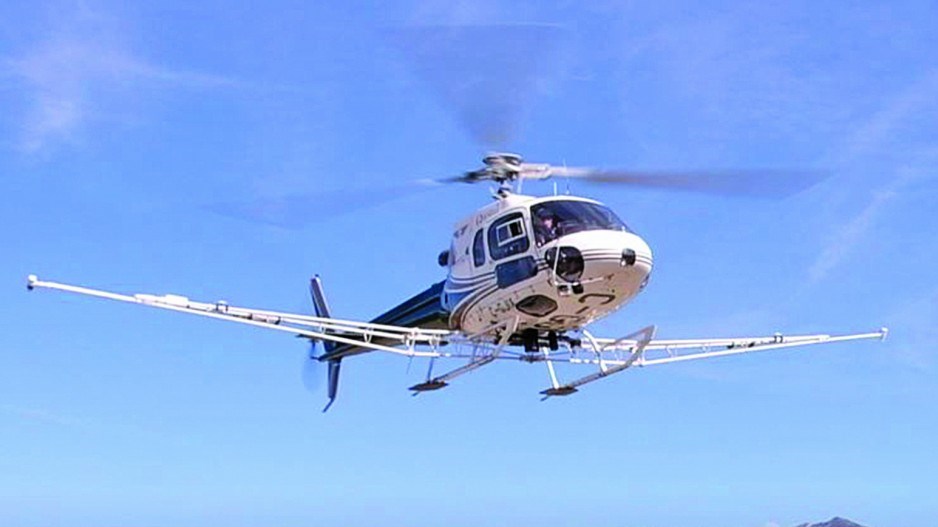A new aeromagnetic map of a 9,600-square-kilometre region of northeastern B.C. that was unveiled near the end of January has produced almost instant results in the form of new mineral claims being staked.
At the Association For Mineral Exploration Roundup conference on January 23, Geoscience BC unveiled its latest mineral mapping exercise. It was the third such exercise in the non-profit organization’s Quest mapping project, which uses low-flying aircraft outfitted with magnetometers to take detailed magnetic readings of a large region.
Since the new Search Phase III map was released publicly, some 250 square kilometres of mineral tenures being acquired, according to Bruce Madu, vice-president of minerals and mining for Geoscience BC.
“We think 250 square kilometres within weeks of the survey is quite significant,” Madu said. “I’m aware of four to six companies that have been picking up new tenures in the area.”
One of the companies applying for mineral exploration tenures was Vancouver’s Serengeti Resources Inc. (TSX-V:SIR).
On March 1, Serengeti announced that it had staked eight claims – a total of 7,670 hectares – as a direct result of the new map.
Serengeti already owns exploration properties in the region, so it is familiar with some of the historical geological data available from previous mining activity. The new survey helps to place that data into the bigger picture.
“I’m always interested when big blocks of geoscience data become available in areas that are right in our backyard,” said Serengeti CEO David Moore. “That’s our principal area of interest. That’s where all of our properties are and we saw an opportunity to leverage our geological knowledge of the area with a new high-quality, tight line-spaced geophysical dataset.”
One of the properties staked by Serengeti has a magnetic signature that suggests it could have nickel and cobalt. Because the latter metal is a key component in lithium-ion batteries and is in relatively short supply, it has become a hot commodity – doubling in price in 2017 to US$75,000 per tonne.
As part of its research for the new map, Geoscience BC flew magnetometer-equipped helicopters at low altitude over 9,600 square kilometres. The magnetometers were used to pick up readings of magnetite, which often occurs along with metals like copper, gold, silver, molybdenum and cobalt.
Information gathered from the surveys is used to create a map that is now publicly accessible on Geoscience BC’s website. The maps put one more tool in the geologist’s toolbox when it comes to zeroing in on areas that might have mineable mineral deposits.
The catalyst for mapping the area, performed at a cost of $1.7 million, was the Kemess mine in the northern Interior.
The open-pit copper mine operated from the mid-1990s to the mid-2000s before shutting down. The mine now has all of its environmental approvals to restart as an underground mine.
Other than Kemess, however, the region has not seen a great deal of exploration activity in recent decades. So when AuRico Metals, which was recently acquired by Centerra Gold Inc. (TSX:CG), resurrected the old Kemess open-pit copper-gold as a new underground mine, Geoscience BC decided it was time to focus on the region.
“We think Kemess is one deposit in the area,” Madu said. “We’re convinced there could be more. And people should first look at Kemess – what does its signature look like in these surveys? – and then apply that to the broader region.”
The first map, Search Phase I, completed in 2015, focused on a region between Terrace, Kitimat and Smithers. The second, in 2016, mapped a region from Smithers to Burns Lake and Houston.
B.C. is not the only region that produces such maps, but, as Madu points out, Geoscience BC tends to do it more often than other jurisdictions.
“What’s unique is, I think, the scale to which we do it here and the frequency with which we are rolling out new data,” he said.
Moore said the map research, which offers “big datasets … that industry can take advantage of,” is “one thing that is really great in British Columbia and that Geoscience BC is really good at.”
Madu noted that, although the junior exploration sector is the biggest user of the data, it is also available to governments and First Nations, which can also use it to anticipate where they might see new activities taking place.
“They’re quite interested in managing natural resources, managing the land base, deciding what areas are sensitive, or what areas are, from their perspective, wide open for exploration.”




